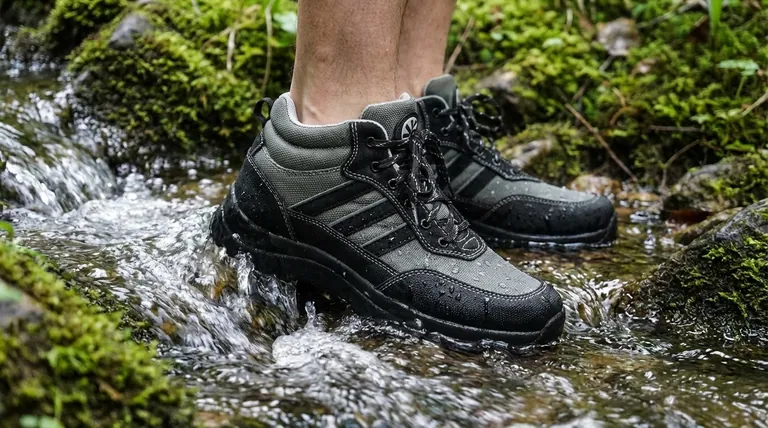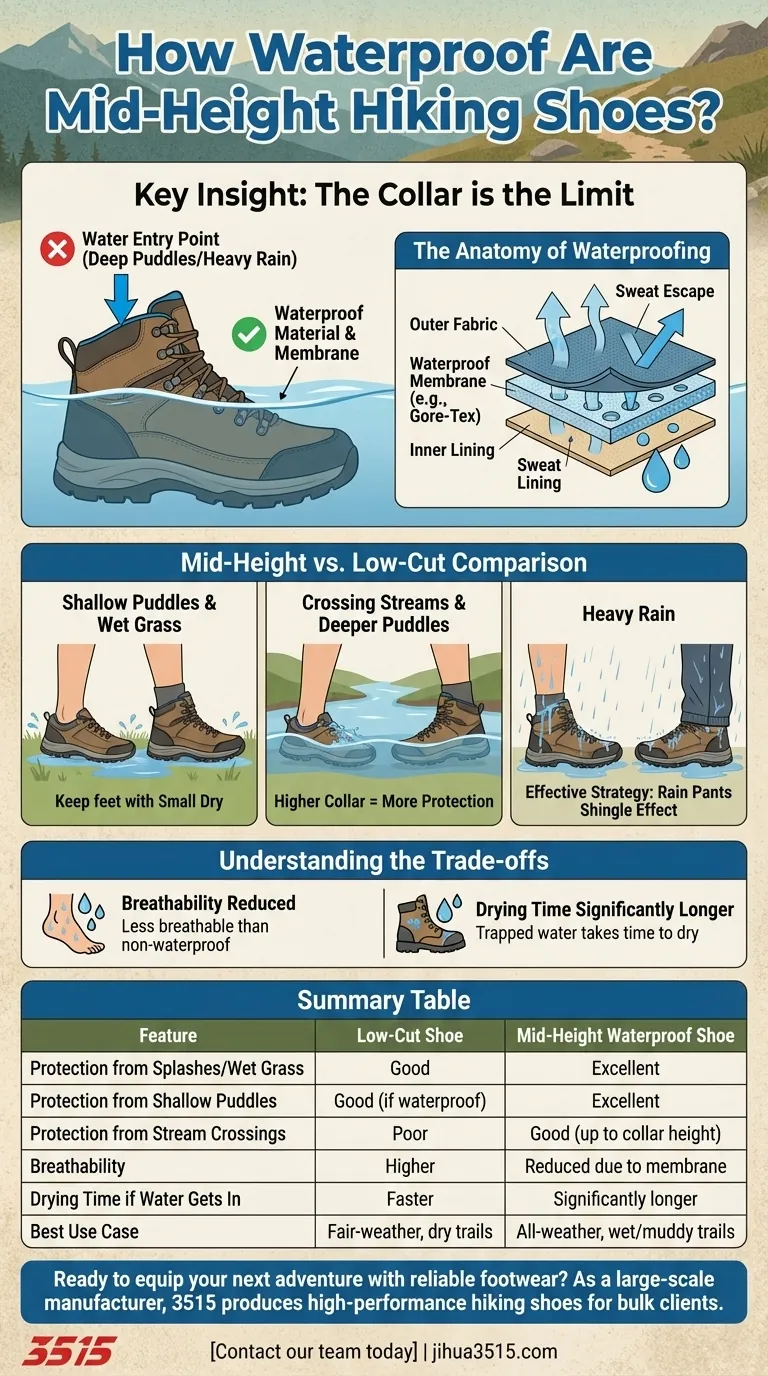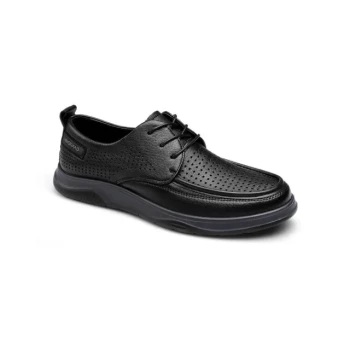In short, yes. A mid-height hiking shoe with a waterproof membrane is designed to be waterproof. The materials will not allow water to seep through from puddles or wet ground. However, its practical waterproofness is limited by the height of its collar, as water can still enter from the top.
The core principle to understand is that while the shoe material is waterproof, the shoe as a system is not invincible. Its effective water resistance is ultimately defined by the collar height, as this is the primary entry point for water in deep puddles, stream crossings, or heavy rain.

The Anatomy of a "Waterproof" Shoe
To understand the limits of a mid-height shoe, you first need to understand how waterproofing works. The protection comes from two key elements: the outer material and the inner membrane.
The Waterproof Membrane
Most waterproof hiking shoes use a specialized membrane, like Gore-Tex (GTX), sandwiched between the outer fabric and the inner lining. This membrane is a marvel of engineering, containing microscopic pores that are large enough to let water vapor (sweat) escape but too small for liquid water molecules to penetrate.
This is why your feet can "breathe" while remaining protected from external moisture.
The Point of Failure: The Collar
The waterproof membrane creates a "bootie" that effectively seals your foot from water below. The single, unavoidable weak point is the large opening where you insert your foot—the collar.
No matter how waterproof the shoe's materials are, if water goes over the top of the collar, your foot will get wet.
Mid-Height vs. Low-Cut: A Practical Comparison
The primary advantage of a mid-height shoe is its superior water resistance compared to a low-cut trail shoe or runner.
Shallow Puddles and Wet Conditions
Both low-cut and mid-height waterproof shoes will keep your feet dry from splashes, shallow puddles, and walking through wet grass. The membrane handles this task perfectly in both cases.
Crossing Streams and Deeper Puddles
This is where the mid-height design proves its worth. Its higher collar provides a crucial extra margin of safety. Water that would easily pour over the top of a low-cut shoe might not reach the collar of a mid-height design, keeping your foot completely dry.
The Challenge of Heavy Rain
During a downpour, water can run down your legs and drip directly into your shoes. While a mid-height shoe offers slightly more protection and delays this process compared to a low-cut shoe, it can still happen.
The most effective strategy here is to pair your shoes with waterproof shell pants, ensuring the pant cuffs go over the outside of the shoe's collar. This creates a shingle effect that directs water away from the opening.
Understanding the Trade-offs
Choosing a waterproof shoe isn't without its compromises. True preparedness means understanding the downsides.
Breathability is Reduced
While waterproof membranes are breathable, they are always less breathable than a non-waterproof shoe. In hot, dry conditions, your feet are more likely to get damp from sweat inside a waterproof shoe than from rain outside of it.
Drying Time is Significantly Longer
This is a critical point. Once water gets inside a waterproof shoe—either from sweat or by going over the collar—it has a very difficult time getting out. The same membrane that blocks water from entering also traps it inside, leading to extremely long drying times on the trail.
Making the Right Choice for Your Hike
Select your footwear based on the most likely conditions you'll face.
- If your primary focus is hiking in fair weather with minimal water: A more breathable, low-cut, non-waterproof shoe may be the most comfortable choice.
- If your primary focus is all-weather hiking with potential stream crossings: A mid-height waterproof shoe offers an excellent balance of protection and mobility.
- If your primary focus is keeping feet dry in sustained, heavy rain: You must pair your mid-height waterproof shoes with rain pants that fully cover the collar.
Ultimately, choosing the right footwear is about matching the tool to the specific challenge of your environment.
Summary Table:
| Feature | Low-Cut Shoe | Mid-Height Waterproof Shoe |
|---|---|---|
| Protection from Splashes/Wet Grass | Good | Excellent |
| Protection from Shallow Puddles | Good (if waterproof) | Excellent |
| Protection from Stream Crossings | Poor | Good (up to collar height) |
| Breathability | Higher | Reduced due to membrane |
| Drying Time if Water Gets In | Faster | Significantly longer |
| Best Use Case | Fair-weather, dry trails | All-weather, wet/muddy trails |
Ready to equip your next adventure with reliable footwear?
As a large-scale manufacturer, 3515 produces a comprehensive range of durable and high-performance hiking shoes and boots for distributors, brand owners, and bulk clients. Whether you need mid-height waterproof models or other specialized outdoor footwear, our production capabilities ensure quality and reliability for every terrain.
Contact our team today to discuss your footwear needs and discover how we can support your business.
Visual Guide

Related Products
- Durable Rubber-Soled Utility Shoes for Wholesale & Custom Brand Manufacturing
- Wholesale Breathable Training Shoes Custom Athletic Footwear Manufacturer
- Premium KPU Athletic Safety Shoes for Wholesale
- Wholesale Durable Camouflage Canvas Shoes with High-Traction Cleated Rubber Sole
- Wholesale Training Shoes with Dial Lacing System Custom OEM Manufacturing
People Also Ask
- What historical breakthrough in 1844 contributed to modern shoe sole manufacturing? The Vulcanization Revolution
- Which type of sole is better for premium sneakers and why? The Definitive Guide to Rubber Outsoles
- What are the disadvantages of leather shoe soles? Key Limitations in Traction & Durability
- What is vulcanized rubber and why is it used in products? The Key to Durable, Flexible Footwear
- What are rubber soled shoes? The Ultimate Guide to Durable, All-Weather Footwear



















